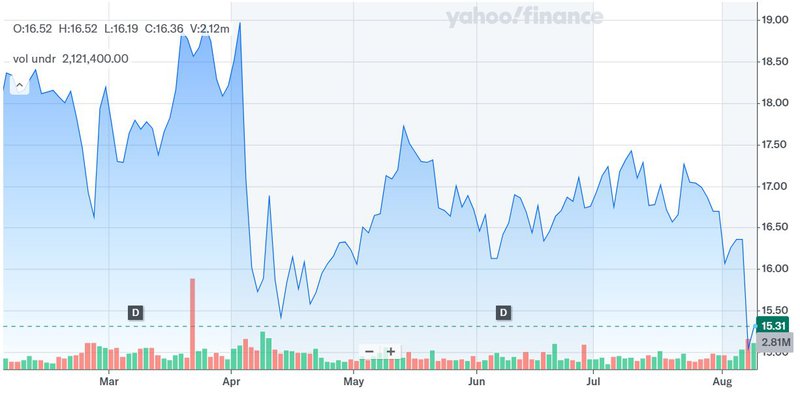Tegna–Nexstar Mega-Deal Could Redefine Local TV Forever!

Tegna Inc (NYSE:TGNA) is back in the M&A headlines, with sources indicating Nexstar Media Group is in advanced talks to acquire the broadcaster in what could become one of the most significant TV consolidation moves in years. Nexstar, already the nation’s largest local television station owner, operates over 200 stations in 116 U.S. markets and owns national properties including The CW and NewsNation. Tegna, with 64 stations in 51 markets and a reach exceeding 100 million people, would add meaningful scale and geographic depth. The discussions come amid a regulatory climate increasingly favorable to large-scale mergers, highlighted by the Eighth U.S. Circuit Court of Appeals’ recent decision to vacate the FCC’s “top four” ownership rule—removing a key obstacle to duopoly formation in major markets. However, the big question is what exactly does Tegna bring to the table for Nexstar and can it truly help the latter achieve deep digital monetization. Let us dig deeper and find out!
Broader Market Coverage & Competitive Scale
A Nexstar–Tegna combination would create an unmatched U.S. broadcast footprint, blending Nexstar’s extensive station portfolio with Tegna’s strong presence in both mid-sized and larger markets. This expanded network would allow for significantly greater household penetration, offering advertisers a unique opportunity to pair national reach with the precision of local targeting. Tegna’s market presence includes regions where Nexstar’s footprint is lighter, providing opportunities for non-overlapping geographic expansion and enhanced audience share. For national advertisers, a unified sales proposition spanning the combined station base could offer more efficient campaign execution, reducing the need for multiple vendor relationships. In distribution, the scale would improve negotiating leverage with multichannel video programming distributors (MVPDs) for retransmission fees, as a larger combined subscriber base typically strengthens bargaining positions. The broader coverage would also enable greater monetization of political advertising during election cycles, a historically high-margin revenue stream for broadcasters. By combining audience reach across key swing states and high-population DMAs, the merged entity could command premium pricing for both political and issue-based advertising. The move would also support cross-platform selling opportunities, pairing broadcast inventory with digital and streaming assets for integrated advertising packages. In a market where big tech firms increasingly dominate ad budgets, such scale provides a stronger counterweight, particularly for regional and local businesses seeking broad yet targeted coverage.
Operational Synergies Through Technology & AI Integration
Tegna’s ongoing operational transformation could amplify Nexstar’s efficiency gains, particularly in technology, automation, and artificial intelligence. Under CEO Mike Steib, Tegna has embedded automation into multiple workflows—ranging from transcription and video editing to lead generation in advertising sales—freeing up staff for high-value creative and editorial work. The company has implemented “zero-waste, zero-based budgeting” and targeted $90–$100 million in annualized nonprogramming cost savings by late 2025, with 80% of that target already achieved. This cost discipline aligns with Nexstar’s own post-acquisition playbook, which historically emphasizes margin expansion through expense consolidation and process standardization. Integrating Tegna’s AI-driven newsroom automation into Nexstar’s broader portfolio could streamline operations across hundreds of stations, reducing per-unit costs while maintaining—or potentially enhancing—content quality. The ability to centralize certain back-office functions, unify content management systems, and consolidate procurement could deliver additional SG&A efficiencies. Beyond cost reductions, Tegna’s AI deployment in content production and ad operations could improve speed-to-market for both breaking news and ad campaigns, enhancing competitiveness in an era where timeliness is critical to audience retention. The “station of the future” model Tegna is building—featuring smaller real estate footprints and lower CapEx requirements—could be scaled across Nexstar’s network, driving long-term structural savings. This operational synergy would be especially valuable as traditional linear TV faces declining audience numbers, providing a buffer to preserve EBITDA margins in a challenging revenue environment.
Enhanced Digital & Streaming Monetization
Tegna’s accelerating digital momentum could provide Nexstar with a stronger competitive position in the rapidly expanding connected TV (CTV) and OTT advertising markets. Over the past three quarters, Tegna’s owned-and-operated digital products have posted strong double-digit revenue growth, supported by expanded local streaming news offerings—more than 100 new hours daily across 50 markets. This content expansion is designed to capture a larger share of the $30 billion CTV ad market, as advertisers shift budgets toward platforms that combine mass reach with precise targeting. Tegna’s Premion platform adds another layer of value, enabling advertisers to target streaming audiences by demographics, interests, and location. While Premion’s revenue was impacted by a reseller relationship change with Gray Media, it remains a strategic asset that could be more fully leveraged within Nexstar’s sales infrastructure. Nexstar could also integrate Tegna’s local streaming initiatives with its own national content brands like NewsNation and The CW, creating a vertically integrated digital ecosystem that spans hyperlocal to national audiences. Enhanced first-party data from a larger digital footprint would improve campaign targeting and measurement, supporting premium ad pricing. As more viewers consume news and entertainment on-demand via streaming, a combined Nexstar–Tegna portfolio could offer advertisers both reach and precision at scale—something national digital competitors cannot match in the local space. This would position the merged company to better compete for shifting ad spend, capturing value from both traditional linear budgets and emerging digital-first campaigns.
Regulatory Tailwinds Favoring Consolidation
The regulatory environment is currently favorable for large broadcast transactions, a key factor underpinning the Nexstar–Tegna discussions. The Eighth U.S. Circuit Court of Appeals’ decision to vacate the FCC’s “top four” ownership rule removes a major obstacle to duopoly creation, pending the FCC’s review period. FCC Chairman Brendan Carr has publicly supported loosening ownership restrictions, citing the need for local broadcasters to achieve greater scale to compete with national and digital media players. This stance aligns with the strategic rationale for a Nexstar–Tegna merger, as the combined company could present a stronger case for serving the public interest through expanded local journalism and more robust community coverage. Tegna’s management has signaled openness to either buying or selling assets depending on market conditions, reflecting flexibility in a rapidly changing industry. Acting during this deregulatory window could allow Nexstar to secure valuable market positions before competitors strike similar deals. While regulatory risks always remain—especially if political leadership changes—the current environment suggests a higher probability of approval for well-structured transactions that emphasize consumer benefits and market efficiencies. In this context, Tegna’s operational health, strong balance sheet, and national reach make it a strategically timed target. By moving now, Nexstar could take advantage of both regulatory momentum and competitive positioning before the window for large-scale consolidation potentially narrows.
Final Thoughts

Source: Yahoo Finance
Tegna’s combination of broad market coverage, disciplined cost structure, growing digital assets, and favorable regulatory backdrop makes it a strategically relevant acquisition target for Nexstar. A transaction could deliver benefits in the form of expanded reach, enhanced pricing power in advertising and distribution, scalable operational efficiencies, and accelerated digital monetization. However, the deal would also involve integration complexity, exposure to cyclical advertising trends, and the ongoing challenge of linear TV audience erosion. On valuation, Tegna’s LTM metrics—1.59x EV/Revenue, 5.81x EV/EBITDA, and 5.53x P/E—suggest a relatively modest market pricing compared to historical industry averages, potentially offering Nexstar a cost-effective path to scale. Whether the acquisition proceeds will depend on deal structure, market conditions, and regulatory execution, but the strategic logic behind the interest reflects the broader consolidation forces reshaping the U.S. broadcast sector.




